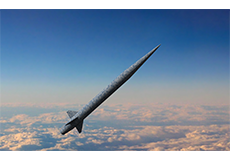UTA students craft winning design
As some nations continue to develop and test long-range, hypersonic missiles capable of reaching speeds beyond Mach 10, it becomes increasingly important for the United States to develop defense systems to engage and destroy such missiles.

A University of Texas at Arlington aerospace engineering student team that crafted a winning design for a conceptual missile system to deploy against such threats led to a mention in the December 24-January 13 issue of Aviation Week & Space Technology.
The team – doctoral students James Peace, Rohit Pulimidi, master’s graduates Nirmal Kumar Umapathy and Mohit Singh, and their advisers, UTA aerospace engineering professor Frank Lu and the late Harry Barnard of Lockheed Martin Missiles and Fire Control – created its design for the 2016-17 American Institute of Aeronautics and Astronautics, or AIAA, Missile Systems Technical Committee Design Competition. After winning the competition, the students presented a paper based on their findings at the 2018 AIAA Space and Astronautics Forum, where it caught the attention of Aviation Week writer Steve Trimble.
“Hypersonic weapon systems have been in the news recently, with various adversaries independently conducting tests of hypersonic glide vehicles or HGVs, and there are currently no existing weapons system to defend against them now,” Peace said. “Many defense companies are focused on developing a hypersonic weapon, but only limited progress has been made toward a deployable counter-weapon.”
The winning design was a single-stage “hit-to-kill” missile system, named ARX, to intercept hypersonic glide vehicles, or HGVs, during cruise. HGVs are launched as payloads atop conventional launch vehicles, separate at the top of the launch arc, then glide through the atmosphere in a series of banks and weaves. Complicating matters, the altitude of the flight path and geometric constraints due to the Earth’s curvature keep the HGVs out of sight of ground-based radar equipment until the vehicle crests the horizon, leaving little time for defenses to react.
The conceptual design relied on a mathematical model that integrated the aerodynamic characteristics, propulsion sizing, and structural constraints with the missile guidance and trajectory algorithm. The team also developed several engineering tools, custom-made for the problem at hand, to aid the conceptual design.
Ideally, ARX is capable of defending a several mile radius against non-maneuvering and maneuvering HGVs at a high altitude and at a high speed. The missile is equipped with a blast fragmentation feature to increase its lethality, so that even if the missile fails to hit the HGV, there is a chance that the fragments will hit and neutralize the HGV.
“I really believe that this is a good concept that would actually work. This competition brought out a lot of talent and imaginative ideas,” Lu said.
The Department of Mechanical and Aerospace Engineering offers bachelor’s, master’s and doctoral degrees in mechanical engineering and aerospace engineering. The aerospace engineering program ranked No. 48 and the mechanical engineering program, No. 87, in U.S. News and World Report’s 2019 graduate rankings. The FSAE, or Formula Society of Automotive Engineering, program has a storied past. Dating back 45 years, UTA has taken three international and eight national championships and has debuted innovative changes in the automotive industry, including wings to reduce drag and an all-electric racecar. The Aerodynamics Research Center houses the only university-housed, arc-heated hypersonic wind tunnel in the United States, as well as low-speed, transonic, supersonic, arc jet and hypersonic shock wind tunnels.